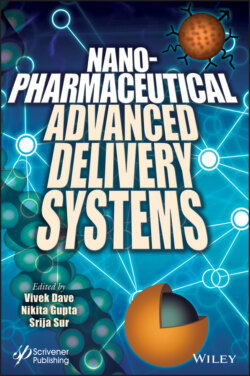Читать книгу Nanopharmaceutical Advanced Delivery Systems - Группа авторов - Страница 15
1.1 Introduction
ОглавлениеEvolution and application of the nanotechnology in pharmaceutical field have brought the development of microscopic drug delivery systems, which have marked the birth of “micro age” drug delivery systems [1]. The beginning of the nano period can be dated back to the late 1970s as a result of the introduction of several nano tools known as nanoscaled medicine systems. A wide variety of colloidal drug carriers including polymer nanosphere and nano-capsules, lipid nanoparticles, liposomes, and micelles are involved in nanoscaled drug delivery systems.
Presently, the development of drugs in the industry is more difficult and challenging because of an increasing number of poorly soluble drug(s) and the lack of targeted therapies. More than 90% of the recorded compounds have water insolubilities and/or are poorly soluble, often due to low bioavailability and a wide intra- and intersubject variation and lack of dosage efficacy [2, 3]. To address these issues, drug formulators need to look for new methods and novel formulation strategies and to ensure effective treatments for vulnerable patients.
Various nanotechnology platforms have received notable attention in the field of medical biology, including diagnostics and therapy. In addition, multifunction nanoparticles as drug carriers have stimulated rapid development of medical applications. Nanoparticles also have superiorities such as increasing drug stability and preventing adverse reactions by prolonged drug release behaviors [4, 5].
Formulating drug delivery system of active compounds with poor aqueous solubility using lipid-based systems is one of the promising strategies. Lipid provides a better alternative for the delivery of various drugs that suffer from solubility-, bioavailability-, and stability-related issues. In many studies, lipid formulations have been tried to increase bioavailability and dissolution of drugs, which are water insoluble [6]. The spontaneous emulsification in aqueous media is one of the major benefits by imparting such carriers to promote delivery of poorly soluble drugs.
Various literatures reported the characteristics and essential properties, design and development, utilization, and potential applications of various lipid-based nanocarriers in drug delivery [7, 8]. The current chapter discusses various lipid-based nanocarriers such as solid-lipid nanoparticles (SLNs) and nanostructured lipid carriers (NLCs), vesicular nanocarriers including liposomes, nanoemulsions, self-emulsifying drug delivery system (SEDDS), and crystalline mesophases in various application pharmaceutical fields. The information on the formulation components and processing aspects has also been discussed in detail.
